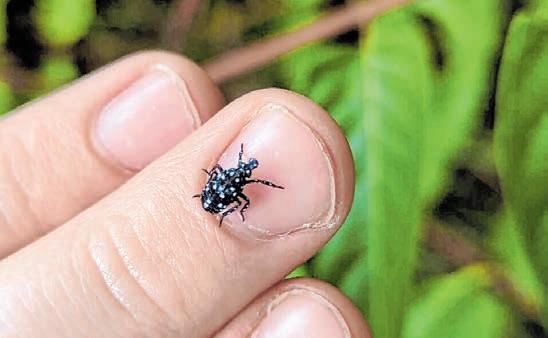
1 minute read
HOME & DESIGN Help Track Spotted
Lanternfly
Tiny black and white spotted insects are emerging from the egg masses laid by spotted lanternflies (SLF) last fall.
Advertisement
Spotted lanternflies (SLF) are invasive insects that feed on grapes, hops, maple trees, and other woody plants, posing a severe threat to our natural resources. Visit agriculture.ny.gov/spottedlanternfly for more information.
In New York, SLF is most common downstate, but one potential pathway for spread is SLF’s preferred host plant, tree-of-heaven (ToH), which is found in many locations across New York. A network of volunteers and professionals across the state are working together to monitor the spread of SLF and ToH. Through the “Claim a Grid Square” program, dozens of volunteers conducted hundreds of surveys across the state last year. The Claim a Grid Square program has been re-launched for continued monitoring. All are welcome to join.
You can help protect New York’s agriculture and forests by knowing what to look for and how to report to New York’s official invasive species database, iMapInvasives.
NY iMapInvasives is managed by the New York Natural Heritage Program (NYNHP), which is a partnership between SUNY College of Environmental Science and Forestry and the NYS Department of Environmental Conservation, with funding from the New York State Environmental Protection Fund.
Visit www.nyimapinvasives. org/slf to learn more about the tracking program.
—New York Natural Heritage Program with lush greenery in a park-like setting, separate deck and patio for entertaining, pavers, attached garage with separate door, and a front porch for relaxing. The driveway has been updated with new pavers allowing for additional vehicle parking adding to the home’s overall curb appeal. This home combines comfort, style and convenience for an ideal living space.

Homes shown here represent closed sales, sold by a variety of agencies and are selected for their interest to readers by the Anton Media Group editor. Except where noted, data and photos are provided courtesy of Multiple Listing Service of Long Island, Inc. and Zillow.
When asked to think of a maritime tragedy, most likely called to mind is the Titanic, which sank amongst the North Atlantic waves in April of 1912. Yet this tragedy was preceded by another, which for 70 years had been considered the worst disaster in maritime history. This was the steamboat Lexington, which ignited and then sank into the Long Island Sound in January of 1840. The Lexington catastrophe caused the deaths of 140 passengers and crew, leaving only four survivors. Despite these chilling numbers, it seems much of the Lexington’s story has been lost in the modern day, as fewer and fewer people know of the ship and the devastation it left behind.










